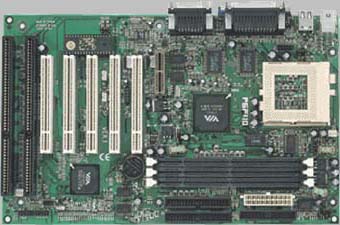With Intel's 810 chipset stealing most of the lime light when it comes to motherboards, the market seems to have forgotten about the new, highly integrated solution from VIA technologies that actually made its first appearance before the 810 was even named. The chipset is the MVP4, and the first boards based on VIA's low cost attempt at the integrated motherboard chipset market are on the verge of shipping. Among those manufacturers with boards ready to shoot out the door, Freetech, a company rarely associated with "high-quality products" is aiming to make their presence known with their MVP4 based offering, the P5F110.
Armed with VIA's latest, albeit not necessarily their greatest, chipset, how far can Freetech go to gain some positive recognition for themselves and remove the cheap branding that has plagued their existence thus far? Let's find out as AnandTech takes a look at one of the first retail MVP4 motherboards...
| CPU Interface | Super Socket-7 |
| Chipset | VIA MVP4 |
| On-Board Video | Trident Blade 3D |
| L2 Cache | 1MB |
| Form Factor | ATX |
| Bus Speeds | 60/66/70/75/80/83/95 100/105/110/115/120/124 |
| Clock Multipliers | 1.5x - 5.5x |
| Voltages Supported | 2.1v - 3.5v (0.1v increments) |
| Memory Slots | 3 168pin DIMM Slots |
| Expansion Slots | 0 AGP Slot 1 AMR Slot 5 PCI Slots (4 Full Length) 2 ISA Slots (0 Full Length) |
| BIOS | Award BIOS |
The Good
| First of all, if you're not familiar with the MVP4 chipset, take a look at AnandTech's review of the MVP4 chipset from last February. After you have a basic understanding of the target market for the MVP4, and the technology behind the chipset you can start looking at motherboards based on the offering. The Freetech P5F110 fits the mold of what will probably become one of the more rarer types of MVP4 boards. The standard ATX layout features a 5/2/0 expansion slot configuration (PCI/ISA/AGP) with a single AMR slot for an add-on soft modem card. | |
| The on-board audio
codec is taken advantage of by the on-board audio input/output ports that are conveniently
stacked next to the parallel port with the rest of the ATX I/O backpanel. The purpose of the MVP4 chipset was to keep costs low while producing a highly integrated motherboard solution, not a high-end offering, making the standard ATX layout and expansion slot configuration of the P5F110 a bit off the mark for the chipset's target audience. Most MVP4 boards you'll see will be available in MicroATX versions and those will probably be more attractive to users interested in the MVP4 chipset. |
|
Keep in mind that unlike most 810 based boards, the MVP4 probably won't be used on boards that are PCI-only solutions. The reasons being that the MVP4 chipset still requires the inclusion of a PCI-to-PCI bridge for the addition of more PCI slots and that a large portion of Super7 users are upgraders that do not wish to throw away their old peripherals (some that may be ISA) just yet. These reasons help make the 5/2/0 expansion slot configuration of the P5F110 a sensible decision on Freetech's part. From Freetech's point of view, the design for a 5/2/1 ATX motherboard is not that much (physically) different from the design for the 5/2/0 layout of the P5F110, keeping costs low, a trend you'll notice with most Freetech motherboards.
The board features a total of 3 DIMM slots with a rated maximum of 768MB of SDRAM, however AnandTech's tests revealed that the board would not function properly with many brands of 256MB memory modules, including the Corsair SEC DIMMs. This brings the realistic maximum down to 384MB for the time being, until 256MB modules become more mainstream and are properly tested by motherboard manufacturers. Chances are that a user looking for the P5F110 will probably not be interested in using 256MB SDRAM DIMMs, so this problem is most likely one that can slide without penalty in the minds of most users. The cacheable memory region of the P5F110 is defined by the 5ns EliteMT L2 cache that is present on the board in the form of two 512KB chips, forming a total of a 1MB on-board L2 cache. The actual cacheable memory region of the motherboard is 254MB, meaning that if any memory is accessed above the 254MB limit, it will result in degraded performance during the accessing of the data stored within that memory space. This, of course, does not apply to K6-3 systems, whose on-chip L2 cache takes care of the cacheable memory area of the system.











0 Comments
View All Comments